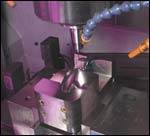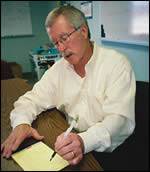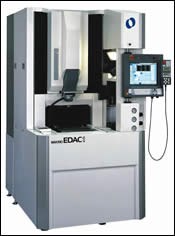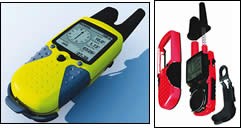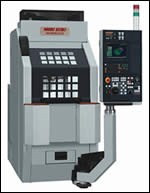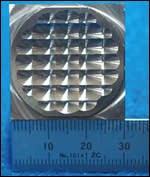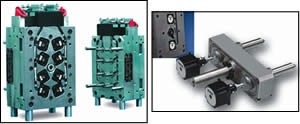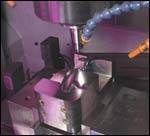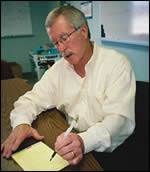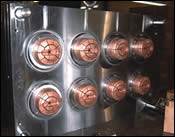Moldmakers Counter Offshore Sourcing with State-of-the-Art Capabilities
Advanced engineering and mold building techniques give North American toolmakers entrée to emerging electronics applications.
Electronics OEMs have outsourced moldmaking operations to low-cost producers offshore for some time. Yet North American toolmakers specializing in high-tech mold design and fabrication are not ceding business to these rivals. Opportunities still exist for these companies, especially where OEMs have product designs, manufacturing technologies and other intellectual property to protect.
Moldmakers that have survived the trend to offshore manufacturing are those most experts put at the top of the food chain in engineering capabilities and productivity. Their ability to work closely with OEMs in developing and refining component design, especially with the continuing emphasis on miniaturization, and in producing tools that expand the parameters of injection molding, give them an advantage over firms whose main selling point is price.
“Our customer base is uncomfortable with going to Asia for molding operations because they’re afraid they’ll lose proprietary ownership of manufacturing,” says Vice President of Engineering Don Hickel at Accede Mold & Tool Co. (Rochester, NY). “We work with our customers on a lot of developing and next-generation manufacturing methods. The technology is very diversified.”
Much of the work that companies like Accede are involved with centers on molds for small or miniature parts like connectors, molded interconnect devices and other components that must be fabricated with precision and repeatability, maintain dimensional tolerance during assembly and use, offer tactile enhancements and, when necessary, meet stringent cosmetic demands.
Two-component molding is, in fact, a growing requirement in many parts for performance and aesthetics. Hickel notes that Accede is developing two-shot tooling for cell phone components and internal computer packaging that combines different grades of liquid crystal polymer in parts that are less than 3 mm. in size. The outer grade will be platable.
“You have to get involved with product design,” says Lisa J. Mauro, U.S. sales engineer for moldmaker Foboha Formenbau (Hamburg, NJ). “With these types of components you have to ask more questions about how they’ll be used downstream, so you can make sure that what you’re designing holds up.”
Suppliers are providing a range of equipment, materials and software that moldmakers need to extend their capabilities. Examples include machining centers and EDM systems that are accurate to within microns and cut radii to fractions of a millimeter; mold components designed for precise, repeatable injection of miniature parts; alloys formulated for fast machining and outstanding surface characteristics; and software that corrects design flaws before molds are cut.
Some suppliers maintain that the equipment they provide can reduce or even eliminate the cost differential between a mold fabricated in North America and one made in Asia. This is application dependent, of course, and confined to high-tech molds. Nevertheless, it can be a deal-maker, especially when such factors as proximity to a customer and speed of delivery are considered. Since the designs of many consumer electronics change as often as every three to four months, fast delivery coupled with engineering expertise is a plus for North American moldmakers.
EDM and Machining Systems
One example of an EDM unit for micro parts is the Roboform 350 Micro Tec, which Charmilles (Lincolnshire, IL) unveiled at IMTS last month. Engineered for workpieces weighing 1100 pounds with dimensions of 31.5 by 21.6 by 14.5 in., the machine uses thermal insulation and vibration damping to keep positioning accuracy at 4 to 5 microns over the work area, says Marketing Manager Gisbert Ledvon. He adds that for most competitive EDMs of this size, variation can range from 10 to 30 microns.
“To do small components, and position multiple small cavities with small features, you must have very good accuracy,” Ledvon says. “This machine is accurate enough to be used by high-end watch makers like Rolex.”
The Roboform 350 has a polymer concrete base to damp vibration and is encased in a thermally stabilized cabin, which keeps work-area temperature at around 68°F to minimize heat-induced expansion, even when the tank is drained and the worktable exposed for short periods. The machine has glass scales on all axes, which improves accuracy readings, and a probe can be installed to record and document measurements without removing a workpiece. Options include a 150-position toolchanger.
Also on view at IMTS was the small-ram EDAC1 EDM unit from Makino (Mason, OH). Engineered for connectors and other components requiring intricate detail, it generates one of the smallest corner radii of any EDM unit, according to Marketing Manager Mark Rentschler—0.005 mm. Surface-finish quality is 0.6 micron Ry.
The EDAC1 also has heat-control technologies to maintain positioning and pitch accuracy, which Rentschler says is +/- 1 micron. These include Thermal Guard insulation materials on the bed, castings and other areas that prevent distortions caused by the shop environment. The Z axis has a thermal stabilizer that’s designed to im-prove its ability to generate tight corner radii and outstanding finishes. The machine handles workpieces of 110 pounds. Its X, Y and Z axes of travel are 8.6 by 7.0 by 8.6 in. Table size is 13.7 by 9.8 in.
Mori Seiki (Rolling Meadows, IL) relies on symmetrical spindle design to reduce vibration and improve the accuracy of its DCG machining line. DCG stands for “driven through the center of gravity” (see What Driven at the Center of Gravity Means to Your Machine Tool, May 2006), which means the spindles and tables on the units are highly balanced, reducing even sub-micron vibrations during operation, says Greg Hyatt, Vice President and Chief Technical Officer for the Machining Technology Laboratory.
The smallest model, the NVD1500 DCG, eliminates 80 to 95 percent of vibration in its axes, Hyatt says. In the X axis, peak-to-peak vibration is 0.14 micron off-center compared to 20.8 microns in previous state-of-the-art machining centers from Mori Seiki; in the Y axis vibration is 1.4 micron versus 7.1 microns; and in the Z axis it’s 0.61 micron compared to 14.3 microns.
Mori Seiki achieves symmetrical balance by installing a ball screw on either side of the spindle, resulting in equal forces and no rotating movement around the guide system. The benefit of this becomes critical as components are miniaturized, Hyatt says. “As the tolerances get tighter and the features get smaller, micron-level vibration errors that are not a problem with large molds become catastrophic.”
The NVD1500 has a 6-inch square work envelope, and is compact enough to fit through doorways. The machine also has a CNC planing function, which improves its finishing capability. “This allows us to put a non-rotating form tool in the spindle and drag it through a complex profile,” he remarks. The result is a mirror finish that’s unobtainable with ball-nose tools, and which can be achieved faster than if done by hand. Hyatt for one believes that the finishing capabilities of machining systems like the NVD1500 can offset the price benefit of offshore moldmaking. “The more complex the cavity and the more difficult the geometry is to polish, the greater the savings.”
The ability to speed mold production is a plus when it comes to cost reduction and short leadtimes. Suppliers are meeting this need in various ways. Hurco Companies, Inc. (Indianapolis, IN) touts its conversational control for machining systems that Marketing Manager Rick Ritter says simplifies CNC programming and reduces setup time.
Hurco equips machines with GE Fanuc controls, but also adds the conversational control, which enables an operator who is not familiar with G Code programming to set up a workpiece. Ritter says the control’s software utilizes a descriptive process that organizes mold cutting into data blocks and uses prompts to verify cutting patterns with interactive graphics based on what the mold and part dimensions should be. Time savings are application dependent, but it generally takes considerably less time to program the conversational control than it does the GE Fanuc control. The control accepts CAM programs, and an operator can call up a line of G Code with it by clicking on a wire model of a part.
Two machines Ritter cites as ideal for electronic components, both utilizing the conversational control, are the VM1G, a graphite machining center, and the VMX42. The VM1G features a 26- by 14- by 18-in. X, Y, Z axis of travel, a 30- by 14-in. worktable, and a 20,000-rpm spindle. The VMX42 has a 42- by 24- by 24-in. X, Y, Z axis of travel, 50- by 24-in. worktable, and a 10,000-rpm spindle. Both machines have positioning accuracy of 0.0002 in. and repeatability of 0.0001 in.
Cutting Tools
As high-speed machining increases, suppliers of cutting tools look to optimize their products to increase efficiency. Ingersoll Cutting Tools (Rockford, IL) promotes high-speed geometries on versions of its Chip-Surfer line. Examples include the high-feed tip, six-flute backdraft tip and new square-bottom end mill. Product Manager Mike Dieken notes that with these tools moldmakers achieve rough and semi-finished outputs of 600 to 1000 ipm compared to 60 to 200 ipm with conventional ball-nose tips. “We encourage people to think outside the ball-nose box.”
The Chip-Surfer line features geometries of up to 10 flutes compared with two to three flutes on many competitive tools. Dieken says that the more flutes a cutting tool has, the greater its throughput. The square-bottom end mill has two serrated flutes and two smooth flutes. Dieken claims this improves harmonic control and makes it easier and faster to cut corners of cavities. He adds that many tools in the line have solid carbide tips that screw into steel or carbide shanks, which reduces the amount of carbide and tool cost.
Emuge Corp. (West Boylston, MA) designs many of its tools for high productivity machining. Examples cited by Steve Jean, Milling Products Manager, include the new Jet-Cut carbide end mills that feature irregular flute spacing to provide smooth cutting with minimum vibration. The Jet-Cut tools are available in diameters ranging from 3/8” to 1” (3 to 20mm), and with positive 10 degree, negative 10 degree and neutral rake angles, which enable these tools to increase speed relative to material removal in a wide range of materials from aluminum to steel hardened to 66Rc.
Regardless of the spindle speed or feedrate, the true gains in increased production are realized through increased material removal, which is the result of deeper cuts and heavy chip loads, notes Jean. Due to the selection of edge geometry, the Jet-Cut tools perform in a wide range of materials from aluminum to steel hardened to 66Rc.
For high-speed milling, Emuge offers solid carbide ball and torus end mills with straight shallow flutes and -2 degree rake angles, providing a ridged and durable tool capable of high feeds with greater than typical depths-of-cut that provide finishing results at roughening speeds, according to the company.
Jean explains that the single insert ball and torus Trace-Cut tools provide an economical solution for finishing in all machinable materials including steel to 63Rc. These high-precision finishing tools provide high concentricity and repeatability through insert changes and also feature coolant thru HSS or carbide shanks.
Hot Runners and Components
An innovative valve gate system powered by an electric drive was unveiled by Ewikon Hotrunner Systems of America (East Dundee, IL) at NPE in June. The system is accurate and repeatable, and assures uniform closure of valve pins to maintain balance in a molding system, says General Manager Dave Boxall.
Ewikon uses a stepping-motor drive that closes valves at the same speed and to the same position. “You get repeatability and cleanliness,” says Boxall. The electric valve gate has sequence capability, so if a mold gets out of balance, adjustments can be made on-the-fly with the controller. The pin position can also be adjusted to project more or less into a part for cosmetic details.
The drive is a rear-mount unit located in the top clamp plate, with the valve passing through the manifold. The unit is independent from the nozzle. Boxall says it can be retrofit to any injection machine, though it is of particular benefit to electric presses. Ewikon has molded parts with it that weigh less than 0.1 g.
Mold-Masters Ltd. (Georgetown, ON, Canada) also offers a valve system that controls the pin positioning to assure quality and repeatability. Called Accu-Valve, the single-phase cylindrical design features a proprietary V-Guide system that keeps resin from migrating between the valve pin and valve disk by creating a thermal barrier within the disk. This prevents excess heat escaping from the manifold and creates a leak-proof seal between the manifold and the valve-pin guide system. The result, says Fabrice Fairy, Director of R&D, is a thermal condition in the gate that allows the pin to close accurately and the part to freeze properly. Accu-Valve can minimize cavity spacing and mold size, which could let a multi-cavity mold run on a lower-tonnage machine.
The same benefit applies to another product, Femto-Lite, a line of low-profile nozzles for use with small parts or difficult-to-reach gating surfaces. Femto-Lite nozzles come in lengths of 73 to 167 mm., have an average width of 10.2 mm., and minimum pitch of 19 mm.
Materials
Metals suppliers offer grades for electronic components ranging from con-ventional P-20 tool steel to beryllium copper alloys that maximize heat transfer. One material that’s gaining notice is aluminum alloy. Suppliers claim these grades offer combinations of hardness and density that yield high machining speeds, outstanding finishes and cost savings.
Alimex North America LLC (Clinton Township, MI) produces a pure 5000 series cast aluminum alloy that Jeff Albee, Manager for North American Sales and Operations, says has excellent machinability and good color-matching properties. Because the grade, ACP 5080R, is 5 percent less dense than most aluminum alloys, moldmakers save money using it.
Albee reports that the alloy is ideal for prototype and production molds, and holds complex geometries and sharp corners well during machining. The grade has a hardness of 75 Brinnel; elasticity and tensile strength of 41 ksi; and a 19 ksi yield. It is “very competitively priced.” ACP 5080R comes in block thicknesses of 0.25 to 40 in.
Distributor Clinton Aluminum (Clinton, OH) sells an alloy called Hokotol, which is made in Germany by Corus Aluminum. A 7000 series alloy, it is heat-treated and offers a high degree of mechanical strength, according to Bob Mang, Sales and Product Manager. “Moldmakers can machine it faster because it’s harder than most aluminum alloys; and it polishes well, so it’s good for cosmetic parts.” The grade costs three times as much as P-20 steel, but machines three to four times faster, has good dimensional stability and better thermal conductivity. It comes in thicknesses of 1 to 8 inches.
Mang says moldmakers are looking at aluminum alloys as a way of reducing machining and finishing costs to compete with offshore sourcing. He’s seen molders get more than one million parts with molds made from Hokotol, and says an undisclosed automotive supplier just converted 50 molds to the alloy from P-20 steel.
Software
Another area of cost-savings is mold design software. Various companies offer products that reduce the time needed to import CAD/CAM drawings, verify designs and begin machining. One such is SolidWorks Corp. (Concord, MA), whose 3-D software has features that Fielder Hiss, Manager of Product Management, says get products to market faster by improving the ability of moldmakers to spot manufacturing problems and work with customers to correct them.
SolidWorks can import and export more than 23 engineering file formats, and utilizes “healing tools” to assure data accuracy. The software verifies design features like occluded undercuts, part thickness and the integrity of structural elements, and calculates if a part can be filled based on its design and the resin specified. A partnership with Moldflow Corp. (Framingham, MA) led to a tool called Moldflow Express that lets moldmakers validate part manufacturability.
Hiss says one important function is “eDrawings,” which lets moldmakers send back to customers via e-mail 3-D models with design problems and suggestions for solutions or requests for feedback (see Thought to Part: Rapid Manufacturing). This resolves problems faster than by sending a fax or a PDF file. “The biggest advantage is better involvement with the customer in the proposal and design process,” he says. “This capability lets moldmakers differentiate themselves, and shows they are invested not only in their success, but the success of their customers.”
Another supplier touting the benefits of its 3-D software is Delcam Inc. (Windsor, ON, Canada). Its PS-Moldmaker produces solid models from imported part-design data, then uses the Die Wizard function to create core, cavity and cooling channels. The software has a catalog of mold bases that can be used in development of a mold, and lets moldmakers store their own designs in a component library. A motion simulation and collision checking function verifies that a mold design will work.
Summary
With all of the activity in design and development, it’s little wonder that the electronics market continues to show strength in the U.S. despite outsourcing.
Figures from the American Plastics Council indicate that electrical/electronics accounted for 2.9 billion pounds of thermoplastics in 2005, making it the sixth-largest resin user among such giants as packaging (25.1 billion pounds), consumer and institutional products (17.4 billion pounds), and building and construction (15.4 billion pounds).
While demand for thermoplastics in electrical/electronics fell 5 percent from 2004 (consumption in other categories declined as well), the market posted the largest compound growth rate between 2001 and 2005: 3.9 percent, a sign of its strength and vitality, and the role that leading-edge design and fabrication capabilities play in advancing product innovation and fabrication economy.
About the Author: Patrick A. Toensmeier has been writing about the plastics industry for 20 years. He can be reached at toensmeier@ sbcglobal.net.
Related Content
Moldmakers Deserve a Total Production Solution
Stability, spindle speed and software are essential consideration for your moldmaking machine tool.
Read MoreIt Starts With the Part: A Plastic Part Checklist Ensures Good Mold Design
All successful mold build projects start with examining the part to be molded to ensure it is moldable and will meet the customers' production objectives.
Read MoreLaser Welding Versus Micro Welding
The latest battle in finely detailed restoration/repair of mold materials.
Read MoreMachining Center Spindles: What You Need to Know
Why and how to research spindle technology before purchasing a machining center.
Read MoreRead Next
It’s Gut-Check Time for Tool Builders
It’s time to adapt or die as business evolution dictates development of new business and manufacturing approaches.
Read MoreMold Builders Carve Lean Niche
Commodity-oriented consumer manufacturing left North America, but mold industry survivors are finding strong growth in technical market sectors.
Read MorePackaging Molds Go High-Tech to Improve Productivity and Economy
The ability to design and build innovative molds for advanced processing needs is key to being competitive and profitable in a low-margin market.
Read More
